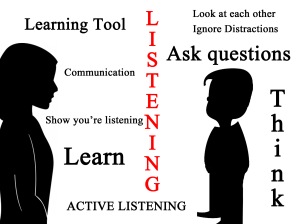Each new day comes
With its prizes unassembled.
Be handy with your tools.
Author unknown
What Is Active Listening?
Opportunity! Yes, the world is filled with opportunity. We look at our young children and we are filled with hope and optimism at their vast potential. But what tools will they need to assemble the prizes? And what can we do to help our children acquire the tools they will need for learning?
One tool they will need is the ability to not just listen, but to actively listen. A long time ago, I used a chart to help myself and my classes learn active listening skills. I’ve forgotten all the exact wording, but it went something like this. We can help our children learn these steps to active listening:
L — Look at the speaker, and lean forward towards the speaker.
I — Ignore the other noises and distractions (Something we all have trouble with).
S — Show with your body that you are listening by nodding your head or with the
expression on your face.
T— Think about what is being said. Active listeners don’t just hear words, they think
about what the words mean and how that fits into their lives.
E — Ears hear what is being said, not mouths. It is difficult to listen and talk at the same
time. Listen closely to hear the words.
N — Not understanding? Ask a question about what was said.
How To Teach Active Listening
One of the best ways to teach active listening is to model it ourselves. As busy adults, this is not always easy. I always found that it was important in really listening to get down on the same level as the young child. Somehow the communication lines are more open when one person isn’t always looking way up at another. And they are certainly more open when the two people are looking at each other, not one looking at a cell phone, or the TV, or something else. Obviously you can’t always do this, but it works if you practice it and encourage your child to do it, too. Stopping what you are doing and actually looking at your child when he/she talks encourages communication, which is what we all want to accomplish.
Help your child think about what is being said by encouraging them to ask a question about it. Now, for the young child this may just be “Why?“ repeated endlessly until you never want to hear that word again. You can answer a lot of those whys, but you can also encourage them to not just ask “Why?” when they already know the answer, and to think about another question about the topic instead of why. They won’t learn this right away, it’s a process.
Help them to relate what was said to their own experiences. This works with reading, too. The more we can relate what we hear and read to our own experiences, the more we will understand it. And, if there are words or ideas your child doesn’t understand, help them relate those to pictures or objects. For example, suppose you were making some cookies and you told your child you were going to put in some cinnamon. If your child didn’t have any experience with cinnamon before, don’t just put it in and go on. Take the time to help him or her understand by letting him/her see it and smell it, taste a tiny bit.
I emphasized “take the time” in the last paragraph as this is what helping children learn is mostly about. Many people have said that the best gift you can give a child is your time. That doesn’t mean you aren’t also helping them learn to do things on their own and to learn on their own. But, as your child’s first and most important teacher, your time with them is precious.
A fun activity with children for developing active listening skills is to go on a listening walk. You can do this inside or out. Walk around together for a short time quietly, without talking, and listen to all the sounds you hear. Then come back and talk about those sounds. ( Good for developing memory, too) If your children are old enough, they might want to draw pictures of what made the sounds, make lists of what they heard, or write a story about it. If you did this every day for a few days, it would be interesting to keep lists and compare them.
If you try the listening walk idea with your child, let us know how it turned out. We’d love to hear about it.
Check out our other posts on helping your child acquire tools for learning.
#11 – Tools For Learning – Observing
#12 – Tools For Learning – Analyzing
#13 – Tools For Learning – Persevering


Pingback:#13 - Tools For Learning - Persevering - The Pelican Family Series
Pingback:#12 - Tools For Learning - Analyzing - The Pelican Family Series
Pingback:#11- Tools For Learning - Observing - The Pelican Family Series
Pingback:#13 — Helping Your Child Acquire Tools For Learning Part 4 — Persevering | The Pelican Family Series
Pingback:#11– Helping Your Child Acquire Tools For Learning — Part 2: Observing | The Pelican Family Series